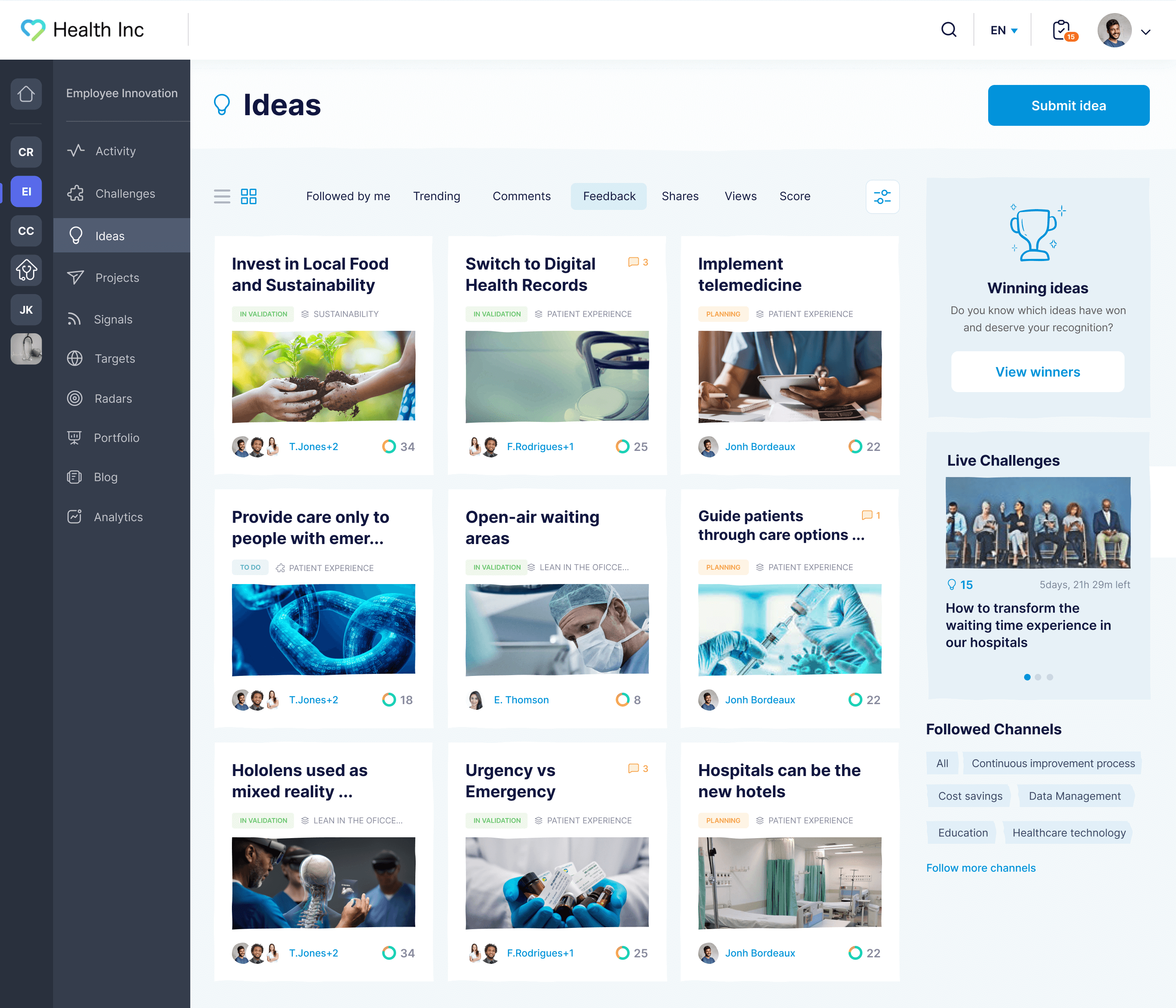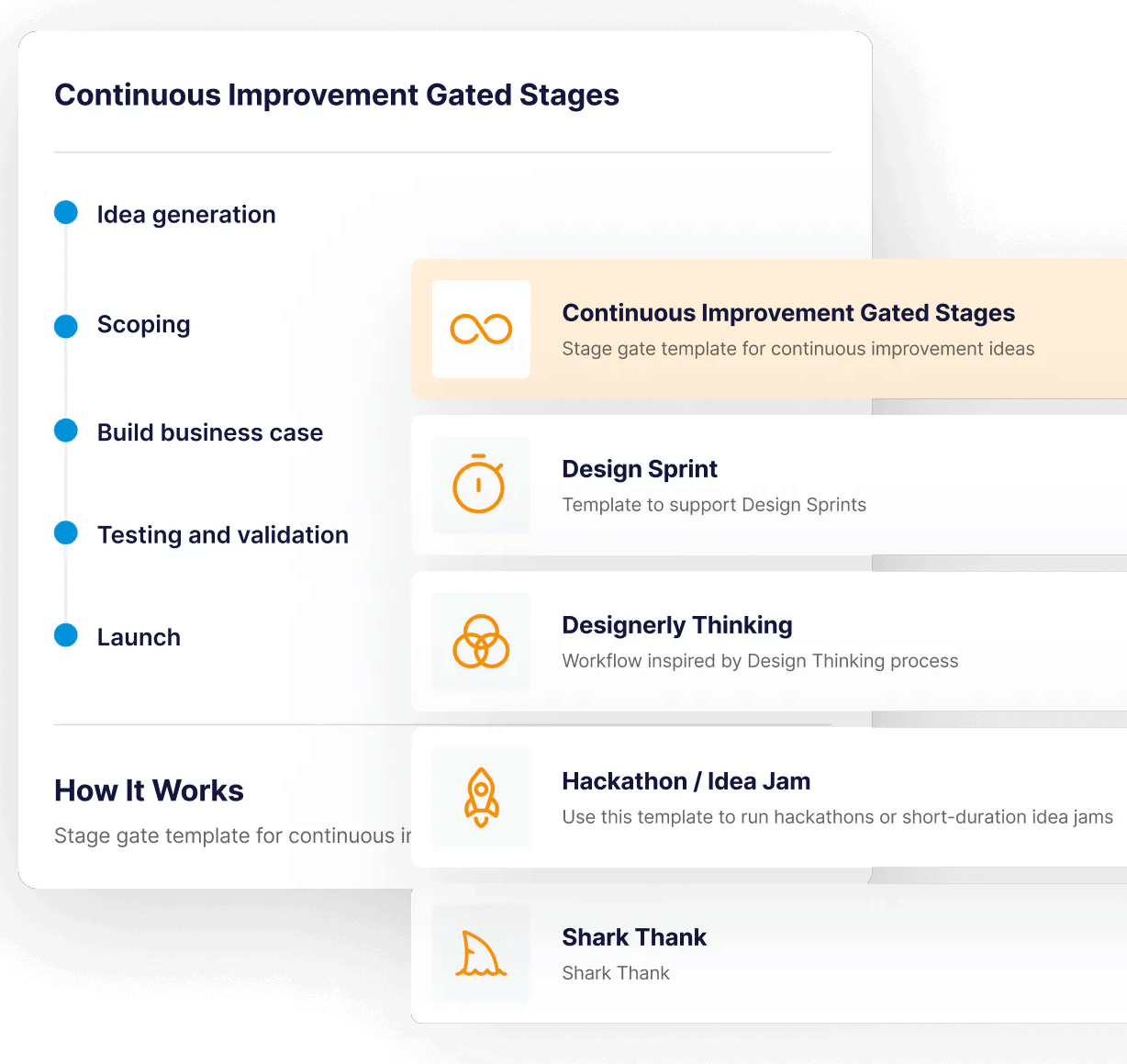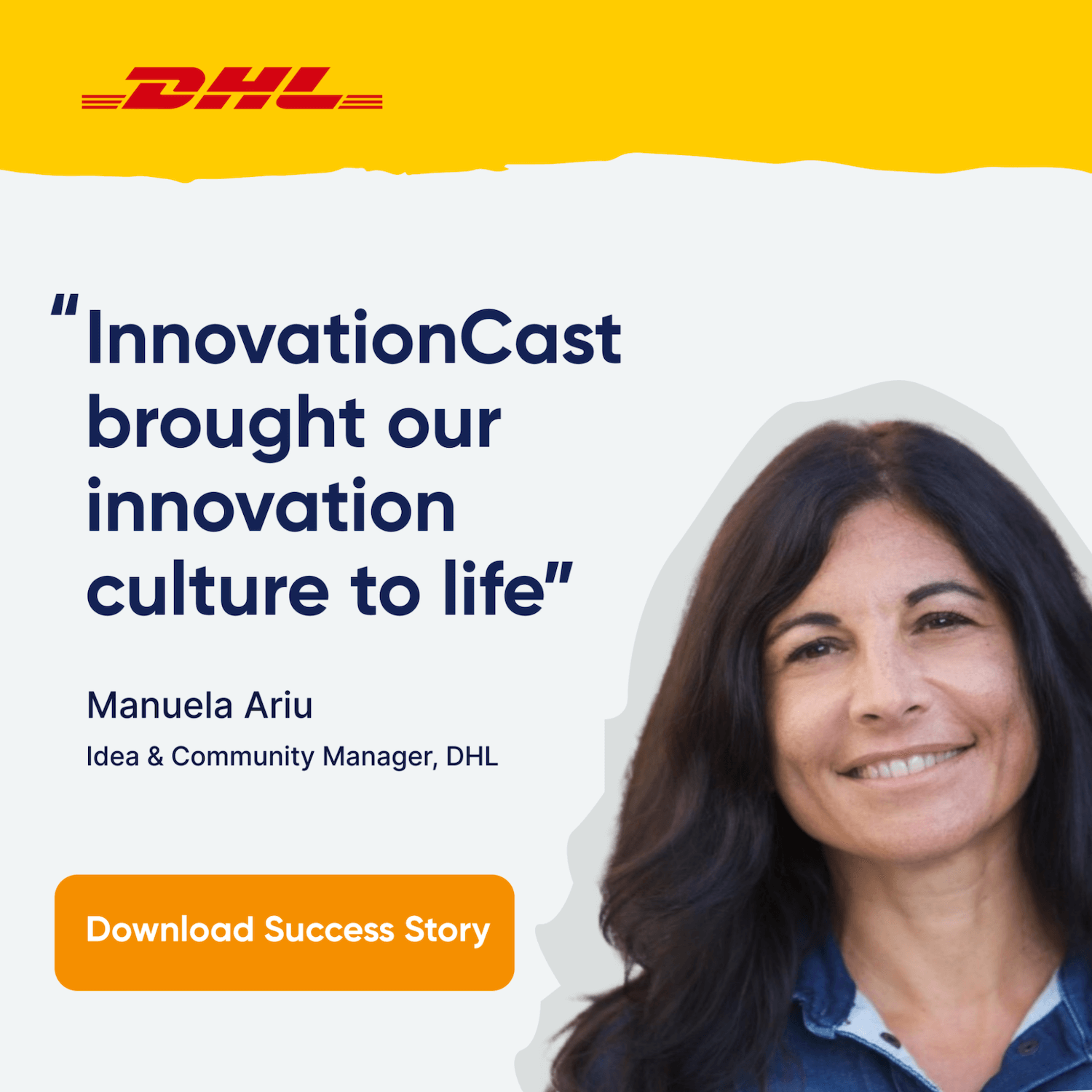“Innovation process” is your system for repeatedly producing, assessing, and launching new ideas across your organization.
In our experience, the key to that definition is “assessing and launching.” Specifically, an innovation process isn’t just a method of collecting ideas, which many organizations routinely do via their employee base, it’s a system to also evaluate and cultivate the best ideas all the way to implementation.
If you have a repeatable system that involves more than just collecting ideas — and can really nurture ideas through evaluation and iteration all the way to launch — then you have an innovation process.
Now, it may not be the best or most refined process — there are other details that make an innovation process good, in particular collaboration and configurability (explained below). However, it gives an organization the foundation to act on ideas and drive innovative projects.
We’ve been consulting with companies for over 10 years, helping them implement software systems to support innovation and collaboration. Many of our clients had innovation teams or departments, but they didn’t have an innovation strategy or solid processes to guide ideas through the steps required for implementation.
In this post, we share what we’ve learned about developing innovation processes and what separates a successful innovation strategy from a flawed one.
If you’re interested in working with our team, you can contact us for a free consultation.
The Key Steps of an Innovation Process (After Idea Collection)
Generally, the steps after idea collection and feedback include:
Assessment and selection, where innovation departments can collaborate and rope in other users to evaluate the feasibility and potential impact of ideas. Then, they vote on which ideas to move forward.
Testing and validation, where teams explore new ideas (especially riskier ideas or ideas with high levels of uncertainty) to uncover risks and potential constraints; this guides decision-making so innovation departments can continue developing ideas before launch.
Implementation, where teams plan the actual tasks to execute greenlit ideas through launch.
Notably, each of these stages can include complex, involved tasks. An effective innovation strategy also calls for input from other user groups in these steps — so you need a method to maintain transparency and collaboration throughout the entire workflow.
For example, the assessment stage could include market research or financial risk analysis. Testing could include building prototypes and gathering customer feedback. Implementation can include product development and planning distribution or marketing strategies to support the release.
Here’s an example workflow for developing new product ideas:

Note: There is no single innovation process that works across the board — ideas need to pass through multiple stages to develop them fully before launch, and different types of innovation projects require different methodologies.
Think about it: You wouldn’t follow the same steps to design and release a new product as you would to upgrade an existing product, shift to a new business model, or change internal processes. Each of these tasks requires a different roadmap for implementation.
Let’s discuss our best practices for idea collection and planning your innovation “roadmaps.”
Strategies for Collecting Ideas & Feedback
Most teams follow what we call the “digital suggestion box” approach to producing innovative ideas. They create a hub for teams to submit ideas — whether through a public form or intranet portal — then innovation teams can see ideas, choose promising ones, and run with them. However, this approach is flawed for many reasons:
There is no visibility or collaboration. Users outside the innovation department can’t see or contribute to submissions; they have no idea what happens to ideas — whether they were good or made any difference — which hurts morale and reduces future engagement.
The feedback network is limited. It’s hard to get other managers or departments outside the innovation team to weigh in during idea assessment — it’s left to just a handful of innovation department team members.
There are no guidelines or deadlines for idea submission. There’s just an open call for employees to submit ideas at random about any topic — innovation departments can’t bring the focus in on specific domains and their challenges. As a result, employees don’t have context on organizational issues, customer needs, ongoing innovation efforts, or the overall business plan and strategy; idea generation isn’t focused on the most pressing needs; innovation departments receive ideas that aren’t comparable. Also, a lack of deadlines reduces motivation to submit.
Here are our methods to avoid these issues:
Create innovation “Challenges” to gather ideas connected to company goals. In these scenarios, innovation teams can provide background about ongoing initiatives or problems they hope to solve. They get everyone in the organization on the same page so other user groups can pitch ideas about specific topics and contribute to problem-solving.

These challenges promote transparency because 1) other users have a look into what the innovation team is working on and how to contribute, and 2) they can see each others’ submissions and work together, which fuels new ideas and promotes better feedback.
Now, that isn’t to say that general idea collection is bad, but you need to approach it more strategically.
The “Always On” idea collection model is most effective when you create pointed submission forms that 1) are on topics of relevance to the organization at that time, and 2) have specific form fields that force employees to think through important aspects of their ideas. These questionnaires weed out bad ideas from the get-go by ensuring that new submissions fall under relevant categories or meet necessary criteria.

Have a method of inducing a vibrant feedback and discussion system or new ideas. Another important component of good idea collection is collaboration.
When ideas are submitted, we find it’s most productive in organizations to have as many employees be able to see them and give thoughtful feedback as possible. So, when designing a process, you need methods to involve multiple departments and user groups during feedback and brainstorming sessions.
Not only does this improve the quality of feedback and allow innovation departments to see ideas to their fullest potential, but it also encourages user engagement in the innovation process, which is important to achieving the “culture of innovation” that so many organizations seek to have. Not everyone has new ideas, but they may have opinions on someone else’s, and seeing what others say may spark a new train of thought.
Finally, this also increases the chances of the wider organization finding and surfacing the best ideas. In many organizations, only a small handful of innovation department managers or other leadership review ideas, but small groups have limited bandwidth to really assess and comb through what can often turn into thousands of idea submissions.
However, by opening up feedback to a larger group (entire departments, or the whole organization), the best idea submissions will be surfaced — garnering more comments, likes, votes, and attention, which innovation managers can then see and focus in on.

Create Flexible Workflows for Assessing & Cultivating Ideas
As mentioned above, this is where we see most teams’ processes begin to falter. Most organizations have some form of idea collection, but systems for assessment, iteration, and validation are limited or often non-existent. But those are essential steps to a complete innovation process.
Innovation teams should design workflows for each of the different types or categories of ideas they anticipate (e.g., product innovations, technological innovations, business model innovations, operational innovations, etc.). They should also determine the user group(s) that need to contribute to each workflow at different stages.
Then, after you have a foundation to follow, you can learn from your processes and tweak flows to improve subsequent projects.
This brings up another point about developing your innovation process — your workflows aren’t set in stone, you should be open to learning from your processes so you can pinpoint inefficiencies and optimize workflows. Then, the solutions you use to manage innovation projects should offer the flexibility to adapt with you.
If you do all of this properly — employ strategic idea collection methods, create clear processes to launch new ideas, and maintain visibility and collaboration through the entire innovation lifecycle — you can create an organization-wide culture of innovation, where everyone in the organization knows, values, and contributes to the innovation strategy.
Read more: What’s the best innovation process to organize innovation management activities?
How to Implement & Sustain an Innovation Process
In our experience, a final logistical component is necessary to tie these pieces together and realistically implement an innovation process: a platform to manage it all — otherwise called innovation management software.
Yes, in theory, you could do this without dedicated software, but in our decade of consulting on innovation and collaborative workflow tools, we’ve found this is hard with existing business toolsets, and most organizations struggle to implement and maintain their innovation process without one.
Why?
For starters, transparent idea collection is challenging with existing tools — you can send details about innovation challenges, but where do users submit ideas? An email inbox or a form? Those are only viewable to the administrators or managers who have set up the form or own the email address. Users could add answers to shared spreadsheets or documents, but those become messy and disorganized. It’s also hard or even impossible for other employees to leave feedback on each idea and keep that feedback organized.
In addition, most tools only support certain stages of the innovation process (like idea collection), or they’re configured to a very specific workflow. Then, teams have to take ideas offline, at some point or another, to continue working on them through implementation. This impacts tracking and stifles visibility and collaboration.
In most cases, teams find they need to build a homegrown solution to meet their exact requirements — which requires significant developer resources and can take months to roll out.
Years ago, when we were consulting with organizations on building collaboration and innovation systems, we noticed these gaps with existing tools so we built a platform to support this innovation strategy.
InnovationCast’s Solution for Innovation Management
The InnovationCast platform supports your innovation process through the entire lifecycle: from idea collection and iteration through assessment and launch. It allows transparency and collaboration during each step and is fully flexible to accommodate multiple workflows and adapt to changing processes.
Our platform includes the above-mentioned features:
Innovation Challenges, so you can gather ideas around specific goals or initiatives
“Always On” idea collection features, with customizable submission forms
Configurable workflow stages to move ideas through assessment and launch
Project and portfolio management tools to plan implementation tasks and track (in-progress and completed) projects

Define Process Workflows (And Create an Unlimited Number of Workflows)
Our platform allows innovation departments to define workflows — and create as many workflows as necessary to support their initiatives. Managers can design workflows to manage new product development, implement new systems or technologies, improve existing services, and so on.

Designing workflows doesn’t require coding knowledge or custom development; users can drag and drop steps into the workflow, change the order, and remove or edit steps at any time.
Support the Entire Innovation Lifecycle
InnovationCast lets users manage the actual tasks to assess and launch ideas in our software. Our system supports elaborate project management so innovation departments don’t have to use disparate tools or take ideas offline after idea collection.
Within each innovation project, we have dashboards (in the screenshot below) to set evaluation criteria and ensure ideas are reviewed fairly; manage the testing to validate ideas and record outcomes; map risks and financial impacts; plan project tasks and track status updates.

Maintain Transparency & Collaboration Through Workflows
Innovation departments can involve other users at any point in their workflows, and our platform gives visibility into projects so other user groups see into what innovation teams are working on.
Innovation departments can open idea collection and feedback to everyone in the organization — even outside user groups like subject-matter experts, research agencies, or your customer base — then specify the users to provide input during evaluation, testing, and the steps thereafter.
We provide collaborative tools at each stage so users can communicate and leave updates within the innovation system (and all details about projects are saved for easy reference).
We also have a variety of key features to spark user engagement outside of idea submission: users can leave feedback on ideas by providing a vote (Good, Not So Good, or Neutral) and an explanation for their vote, they can “follow” ideas to see the latest activity and chime in when they have valuable feedback, and they can share articles on relevant topics to fuel innovative conversations.

All users in your innovation network can monitor ideas and watch as they progress through the workflow. All comments and updates are saved in InnovationCast, visible to others, so users can see exactly what happens with ideas: where they fall off, if they’re successfully implemented, and the outcomes of projects.
Our team can help you implement a strategic innovation program to support your projects and create an organization-wide community of innovation. We tailor our solution on a per-customer basis to help our clients achieve core business goals and organizational growth.
Schedule a free demo to discuss your challenges and learn more about our solution.
Client Story: DHL Uses InnovationCast to Launch a Global Employee Program (And Implement Idea #1 in Just a Month)
DHL is a worldwide logistics, shipping, and transportation company; it operates in hundreds of countries and has over 516,000 employees around the globe. At this scale, they’re a recognized brand that does business with thousands of organizations, big and small.
Before partnering with InnovationCast, DHL had an established innovation team and processes; their challenge was involving the DHL IT services — a distributed team of 5000+ IT professionals that keep DHL running smoothly — in innovation strategies to challenge current DHL solutions and develop new technologies.
After partnering with us, DHL created IdeaHub: a global innovation platform where all teams and partners could connect and collaborate on innovation initiatives.
The innovation department used our workflow engine to design strategies for different types of projects. Their workflows include steps to produce, discuss, and iterate ideas; evaluate ideas with consistent criteria; and prepare ideas for implementation.
DHL launched IdeaHub across all of the countries they operate in (including the US, Germany, Prague, Costa Rica, and Chennai) and executed their first project in less than four weeks.
In the last two years of working with the solution, DHL has seen a 67% increase in submitted ideas, and they’ve successfully implemented 14% of their innovative ideas.
“InnovationCast is a delight to use; its simple, intuitive, and interactive design has brought our innovation culture to life! Additionally, it has been a joy working with InnovationCast every step of the way; from design to technical support to consultancy, their consistent support has been remarkable. This is a group of people who genuinely care, who go the extra mile to make things easier for you, and who wish to see you succeed.”
— Nick Medina, Idea & Community Manager at IT Services, DHL
FAQs
What are the four types of innovation strategies?
Routine Innovations (aka Incremental Innovation or Continuous Improvement) are improvements upon your organization’s existing capabilities — this would include updates and enhancements to existing products, services, processes, and business models. This is the most common type of innovation.
Radical Innovations introduce entirely new markets, products, services, processes, technologies, or industries — the internet, cell phones, cars, and air travel are all basic examples of radical innovations.
Architectural Innovations are when businesses repurpose existing technologies to create new products or services. Apple is a nice example; they’ve used smartphone technology to offer “smart” watches, TVs, headphones, speakers, VR headsets, lightbulbs, home security systems, and more.
Disruptive Innovations shake up existing markets, processes, or business models, and create new market segments or appeal to unmet customer needs. These new ideas eventually replace existing technologies, products, services, etc. Think Netflix pushing Blockbuster (including other brick-and-mortar video rental stores and physical media) into obsoletion; Netflix “disrupted” Blockbuster’s business model with rentals delivered to your mailbox, and eventually, online streaming services.
Read more: What's the difference between breakthrough innovation and disruptive innovation?
What is open innovation?
Open innovation is “opening up” ideation and innovation to external user groups like stakeholders, partners, research agencies, subject-matter experts, universities, and customers. In this innovation ecosystem, internal groups, like innovation teams and employees, can source ideas and collaborate on innovation projects with outside users.
What is an innovation framework?
“Innovation framework” is another term for the innovation process — the steps to implement innovative ideas. It encompasses idea collection and management methods and all subsequent steps to validate and implement innovative ideas.
Schedule a free demo and consultation with our team to learn more about developing your innovation process with our solution.


